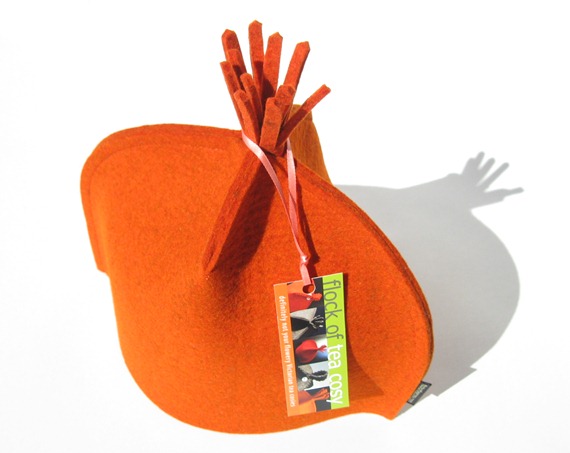
by Flock of Tea Cosy | Flock's Diary of modern wool felt teaware
Have you ever been to the Remodelista site? Everytime I visit I see something I like and the women who run it have “favorite things” listed that I either have or lust after so naturally I think they have exquisite taste. All to say that when they published something on this flock of tea cosies, well, (blush) I just thought that was the cat’s pajamas, as my grandmother used to say.
Here’s the link … “Tabletop: Felt Teapot Warmers from a Flock of Tea Cosy”

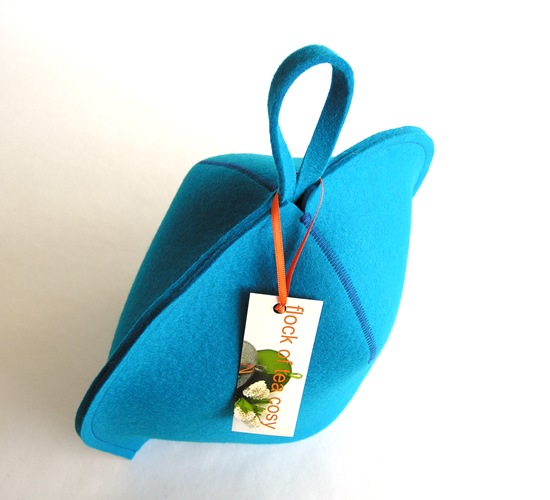
by Flock of Tea Cosy | Flock's Diary of modern wool felt teaware
A wee shoutout to thewirecutter.com for their unexpected mention of FlockofTeaCosy’s wares as a good gift for mom on Mother’s Day. Chest puffed out, head swelling, generally feeling chuffed.
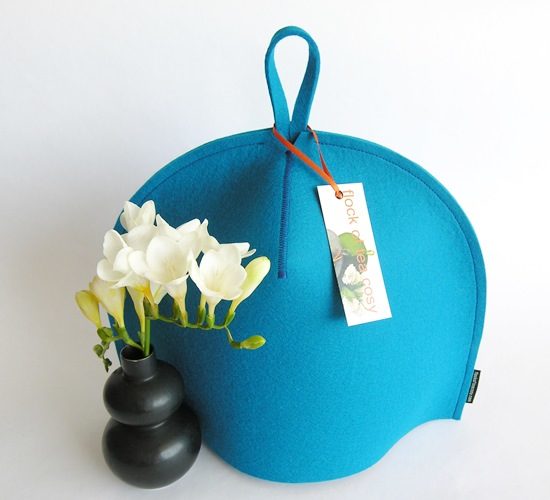
Their item from April 30th, written by the clearly lovely Alex Arpaia was titled “A not too twee tea cozy”:
Does your mother’s taste run more to Heath Ceramics than Blue Willow china? Danish modern rather than Louis Quatorze? Assam loose-leaf instead of Hawaiian Kona dark roast? Then she might just be in need of a tea cozy that doesn’t look like it came from Queen Victoria’s drawing room. One of these simple yet colorful wool-felt cozies—handmade in Toronto by Michaelle McLean, a certified tea sommelier—will keep the tea in her teapot warm all morning. (McLean makes cozies for French press coffee makers and mugs too.)

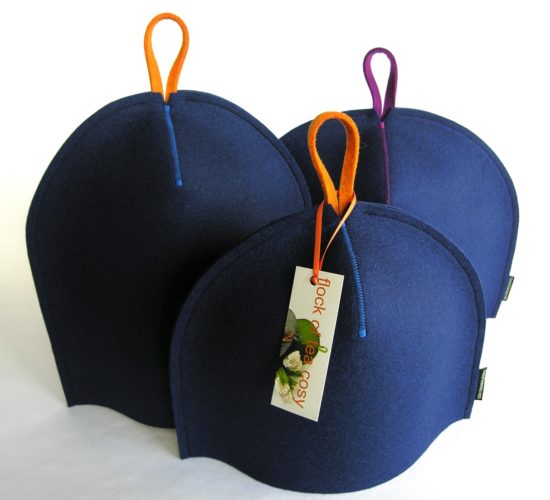
Thanks et merci!
(Postscript: sadly there’s no more of that lovely Peacock Blue wool felt which I got in Spain, perhaps another year, when travel is back. But other lovely colours can beguile.)
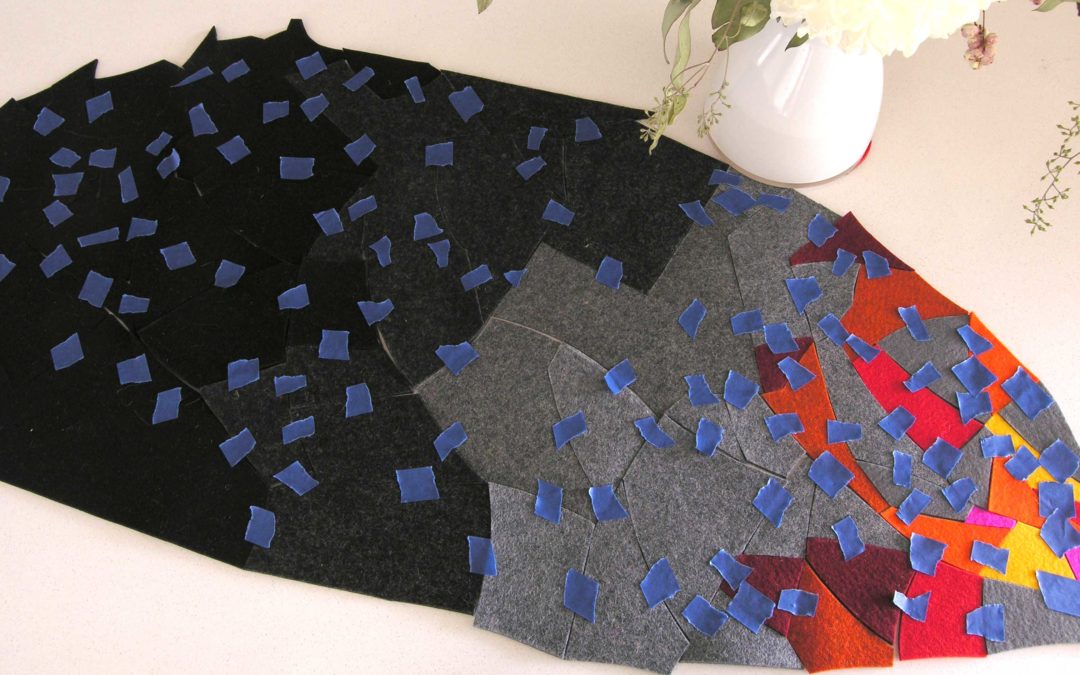
by Flock of Tea Cosy | Flock's Diary of modern wool felt teaware
Every now and again the growing pile of tea cosy wool felt scraps starts to grumble, so the other day I started on another table runner (aka table topper aka hot pad) and several hours of puzzling the pieces together.

A dark comet with a fiery tail is what I had in mind. A friend suggested it could also be a volcano, and another thought a fish.
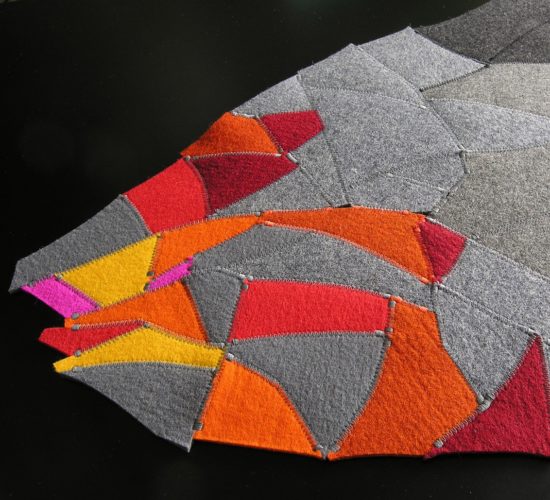
Over the two following afternoons — while listening to podcasts — it was sewn together with zig-zag. Far too many hours in its making to be sensible, but looking pretty smart. Now in the shop.
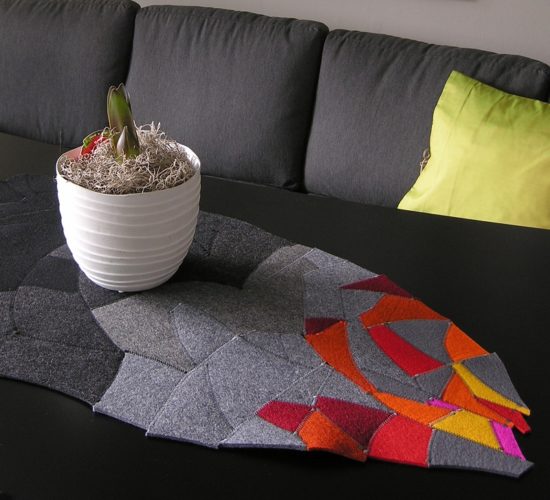
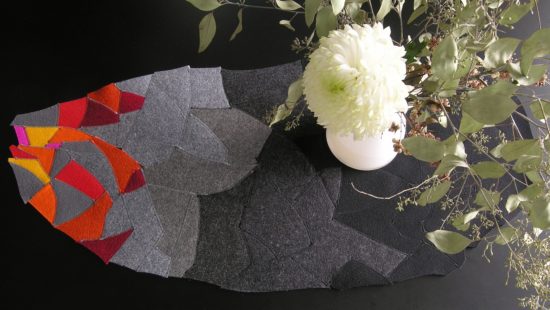
***
I was inspired in part to keep all the felt scraps — besides the fact the felt is so dear — by Ray Anderson, CEO of Interface, an American rug manufacturer who, in the seminal 2003 documentary The Corporation, talked about reclaiming the wasted roll ends of carpets to make more beautiful carpets. By doing this they reduced the amount of petroleum that had to be pulled from the earth and saved their company money all at the same time. That’s eco logic. Waste not, want not.

by Flock of Tea Cosy | Flock's Diary of modern wool felt teaware

Puzzle-piece wool felt tableware
A few years ago the “Puzzle Pieces” were introduced after the pile of tea cosy offcuts next to the sewing machine became too high to ignore. This fine quality, well-made 100% wool felt from Europe was just too dear to throw out — and the colourful scraps far too pretty to ignore.

The excellent manufactured wool felt that Flock of Tea Cosy uses (both the locally made Industrial felt and the colourful European felt) is wonderfully consistent — exactly 1/8″ thick, evenly dense, smooth, crisp and clean looking, and the rich jewel-tone colours are pretty and colour-fast, remaining bright for years. The natural baaa-baaa colour of the industrial felt also holds its natural colour.

Wool felt coasters, trivets, hotpads, table-toppers
I was particularly drawn to this wool felt’s density which makes it an excellent insulator — perfect for tea, coffee and mug cozies. When noodling for ideas of what to make with the many small off-cuts it was primarily the insulating quality that inspired me. The result is a bevy of coasters, trivets, hotpads and table toppers that protect surfaces from hot teapots, warm serving plates, and damp vases.
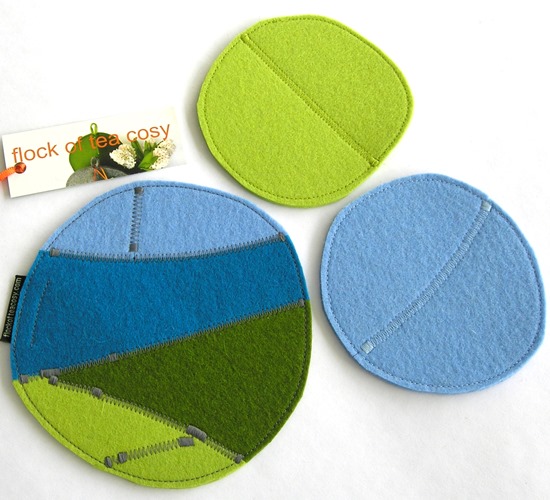
Their making is akin to the quilts or rag-rugs our grand- and great grandmothers used to make using up otherwise useless scraps and small fabric pieces, although I take a much more free-form approach. Their rugs and quilts embodied an ethos that is enduringly forward- thinking and contemporary which we now call “green thinking” or “eco-friendly.”
Carefully fitting the trivets, coasters, etc together is a wonderful piece of puzzling so they’ve been dubbed “the puzzle pieces.”
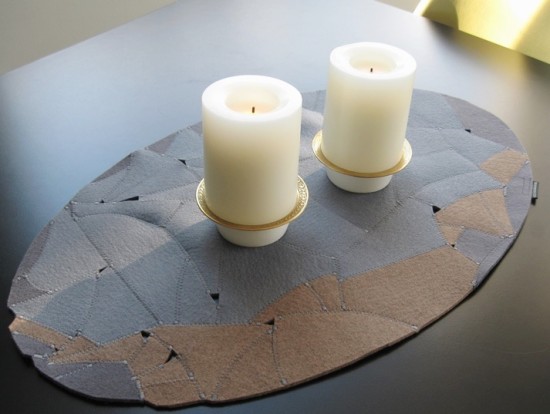
They take a silly amount of time to cut and sew together but I’m very pleased to not be wasting the fabric, and love the final pieces. The felt has a wonderful hand-feel and weight, and the zig-zag stitching holding the pieces together both ensures durability and adds a graphic visual element that I like. I find creating them it somewhat akin to drawing especially as each one is different, like a small piece of art.
‘Cruz Collection’ trivet & coaster sets
Some of the larger offcuts are cut and stitched with a simple cross pattern — dubbed the Cruz Collection and bundled into trivet and coaster sets. They make a perfect complement to one of the tea cosies, or alone as a gift set — a hostess gift perhaps?
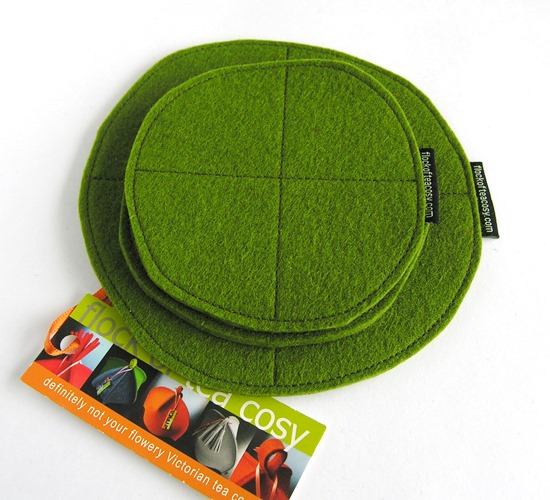
Shop trivets and coasters
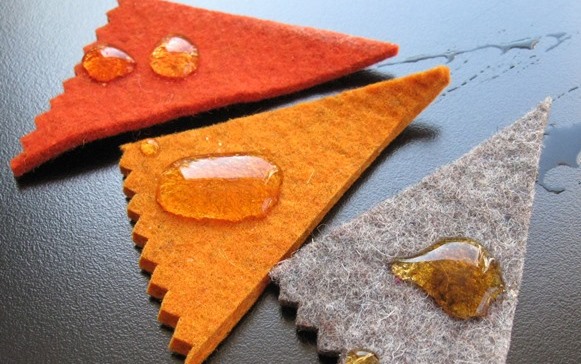
by Flock of Tea Cosy | Flock's Diary of modern wool felt teaware
Tea is widely used as a dye and its stains can be, well, a bugger to get out of a nice white shirt for instance. Since cleaning and care is a common question about these wool felt tea cosies I thought I’d re-post some cleaning tests I did a few years ago.
One can always take it to a dry cleaner, but some simple, quick action is really the best and easiest way to keep your wool felt tea cosy looking fresh and new:
In the name of science herewith a test run of tea stains on some samples of the felt used to make the flock’s tea cosies and a step by step on cleaning.
Firstly, felt is created by washing and mashing and washing and mashing wool so that its fibres all wrap around each other and become the lovely dense mass that we know and love. So don’t pop the felt tea cosy into the wash — either hand or machine — because it will continue the felting process. (Hands up all of us who’ve shrunk that beautiful wool sweater by putting in the washing machine.)
1. WOOL FELT RESISTS LIQUID
The dense wool naturally resists liquid, in this case a teaspoon of fine high-grown ceylon tea.
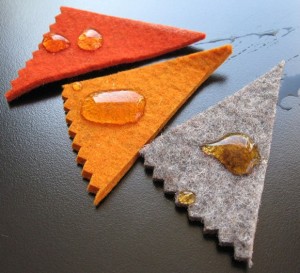
Note how the felt fabric naturally resists the liquid? Now’s the time to quickly blot it up.
2. BLOT THE LIQUID
Use a clean white paper towel or rag and gently blot the liquid. As the stain is absorbed into the paper towel, keep moving to a clean part of the towel so you’re not re-transferring the tea into the felt.
It all comes off with no staining evident.
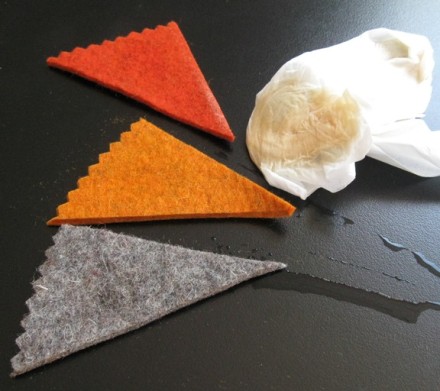
3. HEAVY TEA STAINING
With time and movement the tea will be absorbed by the felt fabric. So in the interest of science (and with some effort) some strong black tea was rubbed in to the wool felt samples. The Cornflower Blue sample was added for this test since it’s a paler colour.
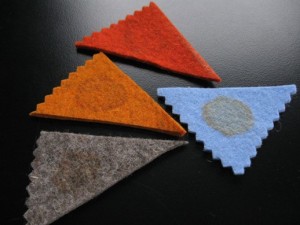
4. SPOT CLEANED AND BLOTTED
The tea spots were lifted on the Tangerine and Burnt Orange by firmly blotting with tepid water using a clean white paper towel. No soap or dish detergent was used — just water.
As the stain is absorbed into the paper towel, keep moving to a clean part of the towel so you’re not re-transfering the tea into the felt. Once clean, the samples were blot-dried using another clean paper towel. I used paper towels because they were handy and white, but a well used clean rag — well used so that all sizing is out of it and it’s super-absorbent — works too, of course.
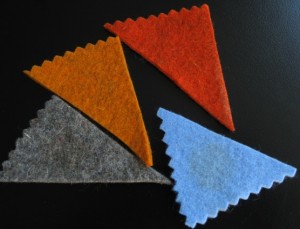
As you can see, there are no spots visible on the Tangerine and Burnt Orange samples, but there are spots faintly visible on the Industrial felt (which is 80% wool) and the Cornflower Blue samples.
5. SPOT CLEANED WITH WATER, SALT AND PEROXIDE BLEACH
So I went to work on the Industrial and the Cornflower Blue samples.
The Industrial came clean with just a bit more blotting with tepid water and clean white paper towel.

On the Cornflower Blue I tried i) baking powder (didn’t work), ii) salt (worked a bit) and finally iii) some hydrogen peroxide bleach. And it worked! I put about half a teaspoon on the sample and let it soak for a few minutes, then blotted it as dry as I could with clean white paper towel and let it dry on the windowsill.
Note: I used no soap or detergent in this test, either of which would have required rinsing which means more work and more wear on the felt finish.
THE UPSHOT
- Felt is naturally stain resistant (although not stain proof)
- Quickly blotting with a clean white paper towel or rag takes care of most accidents
- For settled stains, gently infuse the spot with tepid water and firmly blot with a clean white rag or paper towel. As the stain is absorbed into the paper towel, keep moving to a clean part of the towel so you’re not re-transferring the tea into the felt. When clean, blot dry (press firmly) with clean dry material. This generally does the trick.
- For the pale cosy colours I’ve had success with short (2 minute) spot-infusions of peroxide bleach (never use regular bleach) followed by gently blotting with tepid water, and finally blotting dry.























